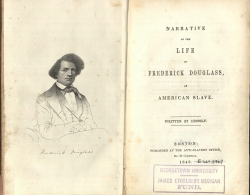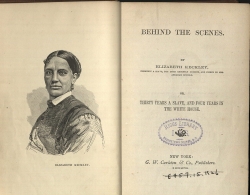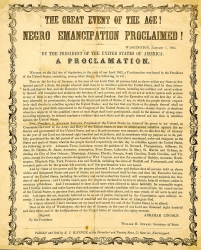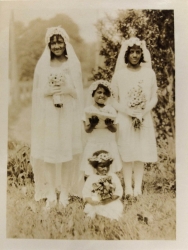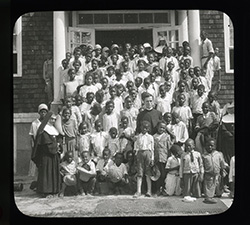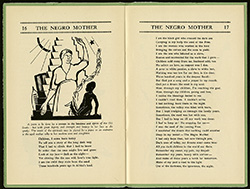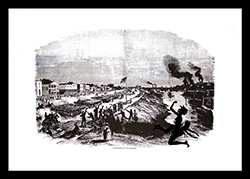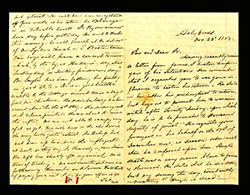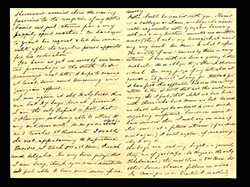Juneteenth across the Library's Special Collections
The Georgetown University Library offers a wide variety of primary materials for those interested in learning more about slavery, emancipation, and African American history. In honor of Juneteenth—the holiday celebrating the emancipation of enslaved people in the United States—Library staff highlighted materials from the manuscript, art, rare book, and archives holdings of the Booth Family Center for Special Collections and the Woodstock Theological Library. If you would like to know more about these items, or our other collections pertaining to slavery, freedom, and beyond, please contact us.
Narrative of the Life of Frederick Douglass, An American Slave (1846)
Slave narratives—harrowing autobiographical accounts of individuals’ experiences of enslavement, usually written after escape—were particularly instrumental in exposing slavery’s horrors and galvanizing antislavery activism. The Narrative of the Life of Frederick Douglass, An American Slave, published in 1845, is perhaps the best known of these narratives. Taught to read the Bible by one of his enslavers, Douglass explores the impact of family separation, the violence of his enslavers on a Southern Maryland plantation, and the events leading to his escape to the North. The Narrative demonstrates the subversive power of literacy and the rationale for anti-literacy laws throughout the South. It quickly became a bestseller and solidified Douglass’s reputation as an exceptionally eloquent and insightful writer. Our 1846 copy of the work features a frontispiece portrait of Douglass, who would become the most frequently photographed American in the 19th century.
Behind the Scenes, or Thirty Years a Slave, and Four Years in the White House (1868)
Narratives by formerly enslaved people continued to be published after the culmination of the U.S. Civil War. Such texts often showed the extremely varied life experiences and accomplishments of Black individuals both before and after emancipation. One such text is Elizabeth Keckley’s 1868 narrative, Behind the Scenes, or, Thirty Years a Slave, and Four Years in the White House. Born into slavery in 1818, Keckley became a successful dressmaker, and eventually used loans from her customers to purchase both her own freedom and that of her son. She moved to Washington, D.C. in 1860, set up a dressmaking shop, and became the dresser and personal friend of First Lady Mary Todd Lincoln. Our copy of Keckley’s narrative features the portrait of a successful businesswoman who was the close confidante of the most influential family in the country—and who had navigated life under enslavement, life as a free woman in slave society, and life after emancipation.
“The great event of the age! Negro emancipation proclaimed!" (January 1, 1863)
The Emancipation Proclamation, issued by President Lincoln to take effect on January 1, 1863, declared "that all persons held as slaves" within the rebellious states "are, and henceforward shall be free." This proclamation did not end slavery, but it did change the legal status of millions of formerly enslaved people living in the Confederacy, paving the way for the passage of the Thirteenth Amendment—which abolished involuntary servitude and chattel slavery— in 1865. So that member of the public could become intimately familiar with “The Great Event of the Age,” the Emancipation Proclamation circulated widely as a broadside. This inexpensive, legible format allowed the Proclamation to be posted on buildings, displayed in homes, and read again and again by a wide array of people.
Dorothy Chance, Violetta Parker, Geraldine Parker, and Thomasene Chance as May Queen and Attendants, St. Peter Claver Sodality, Maryland (1929)
After emancipation, some Black Catholics in the Maryland region remained loyal to the church and in the employment of the Jesuits, their former enslavers. Many participated in church sacraments and rituals, took pride in their Catholicism, and found community in their congregations. They established and contributed financially to their own sodalities, benevolent associations, feasts, and parish fairs—carving a separate social space that enabled them to provide one another with spiritual care, charitable assistance, and a common voice to address grievances within their churches.
For example, at St. Alphonsus Church, which the Jesuits of Woodstock College ministered, Black people formed the St. Peter Claver Sodality. Its members reveled in the annual May Procession, a parade that honored Mary, the mother of Jesus. At St. Inigoes, the Black members of St. Michael’s Church separated from that parish to form St. Peter Claver Church. Its parishioners established a parochial school run by the Oblate Sisters of Providence to educate children of the poor agricultural community in that region. This image and the one below—the May Procession and the Oblates portrayed with their students—suggest the importance of Black women in nurturing religious devotion and education in the 1920s and 1930s. In this photograph, Dorothy Chance, Violetta Parker, Geraldine Parker, and Thomasene Chance pose as the May Queen and her Attendants, St. Peter Claver Sodality, Maryland, 1929 (Woodstock College Archives, IP-3.5, Box 38).
Horace McKenna, S.J. and members of the Oblate Sisters of Providence with Students, St. Peter Claver School, St. Inigoes, Maryland (circa 1933)
In this circa 1933 photograph, Horace McKenna, S.J. stands with members of the Oblate Sisters of Providence and students of St. Peter Claver School, St. Inigoes, Maryland. The photographer has not been identified, and the image itself was found in a slide show used by the Jesuit community at St. Michael’s Catholic Church in Ridge, Maryland. It is now part of the Archives of the Maryland Province of the Society of Jesus here.
The Emancipation of the Negroes—The Past and the Future (1863)
Thomas Nast’s The Emancipation of the Negroes, January, 1863—The Past and the Future, straddles the pre- and post-emancipation eras. Printed for Harper’s Weekly shortly after the Emancipation Proclamation, this piece by Nast illustrates the horrific abuses of slavery on the left (violence, fear, objectification), but also the hopes of emancipation on the right (wages, property, education). A Black family is centrally located in a vignette of domestic tranquility, foregrounding the promise of emancipation. In a smaller vignette underneath, a New Year’s baby breaks the chains of an enslaved man.
The Negro Mother (1932)
The Negro Mother by Prentiss Taylor was printed in 1932 for Langston Hughes’ The Negro Mother and Other Dramatic Recitations, and graces both the cover and the titular poem. Prentiss’ print beautifully captures the spirit of the poem, which is written from the vantage point of a symbolic mother, encompassing the previous generations of the enslaved. It is a cry to the generation of the 1930’s not to forget their ancestor’s past enslavement, but to use that collective experience of oppression as an inspiration to face the obstacles of the present. It ends with the following hope-filled call:
Remember my years, heavy with sorrow -
And make of those years a torch for tomorrow.
Make of my pass a road to the light
Out of the darkness, the ignorance, the night.
Lift high my banner out of the dust.
Stand like free men supporting my trust.
Believe in the right, let none push you back.
Remember the whip and the slaver's track.
Remember how the strong in struggle and strife
Still bar you the way, and deny you life -
But march ever forward, breaking down bars.
Look ever upward at the sun and the stars.
Oh, my dark children, may my dreams and my prayers
Impel you forever up the great stairs -
For I will be with you till no white brother
Dares keep down the children of the Negro Mother.
Occupation of Alexandria (2005)
Kara Walker’s The Occupation of Alexandria, from her work Harper's Pictorial of the Civil War, comments on the way in which narratives of the Civil War often place the Black community in the background. The silhouetted figure of a Black nude woman, with a child emerging from her back, foregrounds the monstrosity of slavery onto the typical historical narrative of heroic battles and military actions. At the same time, the figure of the child emerging calls to mind the new beginning and new freedom brought about by the abolition of slavery.
Patrick Healy, S.J., Photograph (1873)
Extensive documentation can be found in the Archives and manuscripts collections, including the Archives of the Maryland Province of the Society of Jesus and the Patrick F. Healy, SJ Papers regarding the career of Healy, who entered the Jesuit order in 1850 and served as president of Georgetown University between 1873 and 1882. This photograph by Julius Ulke was taken in 1873 at the start of Healy's tenure.
Letter from Patrick Healy, S.J., to George Fenwick, S.J. (November 23, 1853)
Within the considerable holdings pertaining to Healy, only one document clearly acknowledges what is now widely recognized: he was the first Black president of any college in the United States. Patrick Healy was the third son of an Irish-American planter from Georgia, Michael Healy, and a woman enslaved by him, Mary Eliza Smith. Michael Healy sent Patrick to Holy Cross in 1844 with the intention that he “pass” as white. There was awareness among other students of Patrick’s racial ancestry. In a letter written on November 23, 1853 to George Fenwick, S.J, former teacher at Holy Cross who sold the people owned by his family in the 1830s, Patrick Healy confessed to “very intense” anxiety: “Placed in a college as I am, near boys who were well acquainted either by sight or hearsay with me & my brothers, remarks are sometimes made (though not in my hearing) which wound my very heart.” Acceptance by Fenwick, and probably by Jesuits who benefited from slavery, was critical for Patrick Healy and his siblings to pass as white. They needed to become part of the culture of slavery themselves.
Curated by Cassandra Berman, Mary Beth Corrigan, and Adrian Vaagenes.

